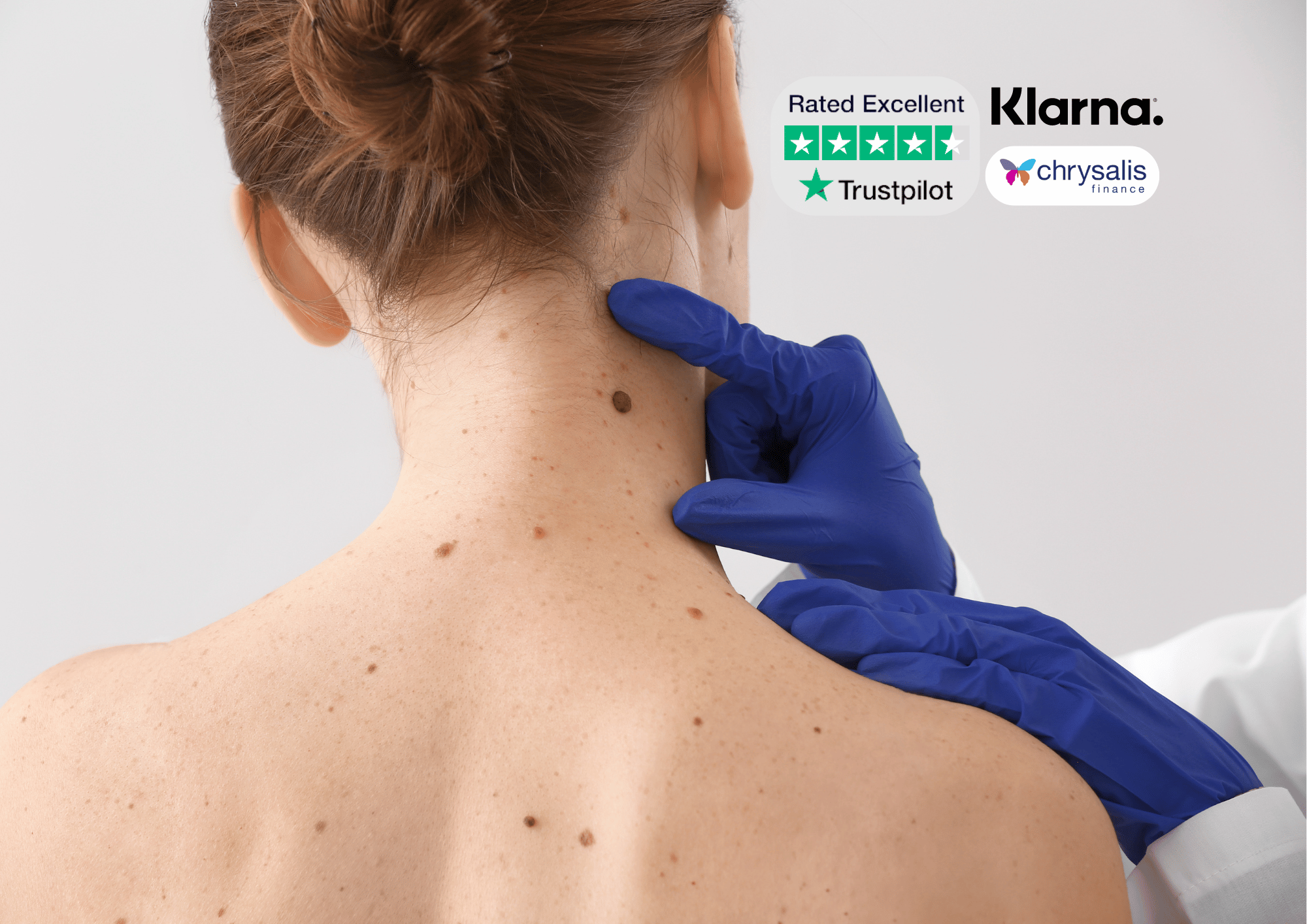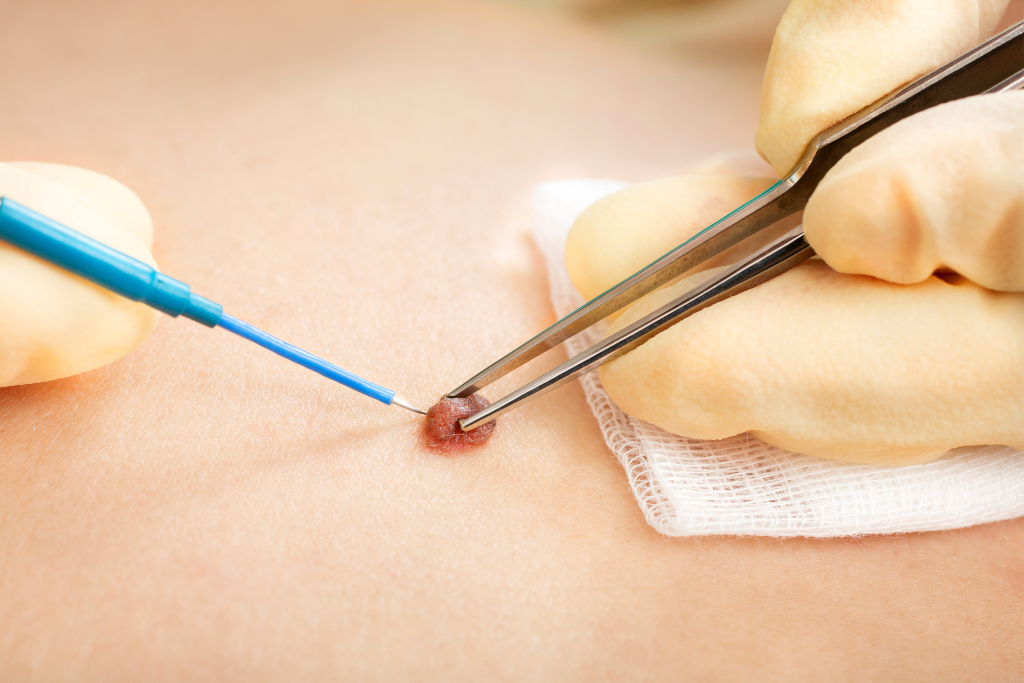If you're worried about your moles or skin lesions, you can schedule an appointment with our specialist dermatologists without needing a referral from your doctor. The 30-minute assessment includes a full examination of any moles or lesions. Most moles are harmless, but you should get them checked if they change in shape, size, color, or start itching, crusting, ulcerating, or bleeding, as these could be signs of melanoma or other skin cancers. If you're unhappy with the appearance of your moles, you can consult a dermatologist for removal, and the sample will be tested for disease. Moles can be brown, tan, black, or other colors, usually oval or round, less than 6 millimeters in size, and can appear anywhere on your body.
17,500 people diagnosed with melanoma skin cancer each year in the UK.

Private Mole Removal Clinic
- Private Mole Specialist
- No NHS GP Referral Required
- No Waiting Lists
- From £250
- Clinics In Manchester, Liverpool and Newton-le-Willows
- Same Day, Late Night and Weekend Appointments Available

How do I know if a mole needs to be checked by a Dermatologist?
If you have any new or existing moles that change, you can use the ABCDE rule to check if you need to get them checked by a Dermatologist.
- Asymmetry
- Borders (the outer edges are uneven)
- Colour (dark black or multiple colours)
- Diameter (greater than 6mm)
- Evolving (change in size, shape or colour)
Our convenient clinic locations:
Frequently Asked Questions.
Our expert team are always hand to help, advise and arrange appointments with our specialist consultants.
What is a Histopathology used for?
Histopathology is the examination of tissue samples removed through a diagnostic biopsy or excision from a mole/wart/skin tag or general skin lesion.
A sample of your tissue (whether suspicious or not) is sent to a private laboratory where a doctor called a pathologist studies it under a microscope. It is a process that will test the sample for signs of disease, in order to observe the appearance of diseased cells in microscopic detail.
This is now best practice in healthcare - sampling all skin lesions for Histopathology, and therefore helping the clinician to identify any disease concerns.
Why have mole removed?
Moles are usually asymmetrical, range from tan to dark brown in colour and are usually smaller than 6mm. Most moles are harmless but any changes to their colour, size or shape could indicate an increased risk of a melanoma or basal cell carcinoma (types of skin cancer).
Moles are extremely common skin growths which can appear anywhere on the body. Checking moles frequently means that your skin specialist will be more likely to spot any changes in a mole.
Therefore we can spot any suspicious changes, and have these tested with histopathology and removed to prevent any further risk.
What is a shave exicison?
A shave excision is a simple procedure that our Consultant Dermatologist may use to remove skin lesions and growths, such as moles, warts and skin tags from your skin. The primary tool used in this procedure is a sharp razor and possibly an electrode to feather the edges of the excision area to make the wound/scar less noticeable.
A shave excision may take a number of weeks to heal completely, depending on the size of the wound and its location. Aftercare is straightforward, with cleansing the wound until healed and allowing allow any scab formation to form and break off on its own.
What is a Diagnostic Biopsy?
A biopsy is a small sample that will be taken and examined in a laboratory. A biopsy is when only a portion of a lesion, tissue, or skin is removed in order to obtain a diagnosis looking for signs or changes that may indicate disease. Taking a biopsy of a lesion is not removing it.
What is a diagnostic biopsy used for?
A biopsy is used for testing in the laboratory for signs of cancer or other diseases. The biopsy sample is stained and examined under a microscope in the lab. It may also be used to identify possible cancer or causes of inflammation and infection.
The area to be biopsied is thoroughly cleaned and numbed with a local anaesthetic. A sterile scalpel is used to cut away a small piece of tissue, and then the wound is stitched (sutured) closed.
Who performs the Biopsy?
Our Consultant Dermatologists are fully-trained in adult and paediatric dermatology, which enables them to identify, offer advice on, and treat a wide range of skin ailments.
What is a Full Excision?
A full excision simply means to completely remove. The full excision process uses a scalpel, laser or another instrument to completely remove the tissue in question, rather than just a part.
This process can be used to treat many forms of skin lesions in addition to melanoma and non-melanoma skin cancer.
Alike a shave excision, aftercare is straightforward, with most wounds taking 1-3 weeks to heal. If a large area of skin was removed healing may take longer. Some soreness around the site of the wound is normal.
Enquire About Our Services
A member of our team will be in touch with you to discuss your requirements.



